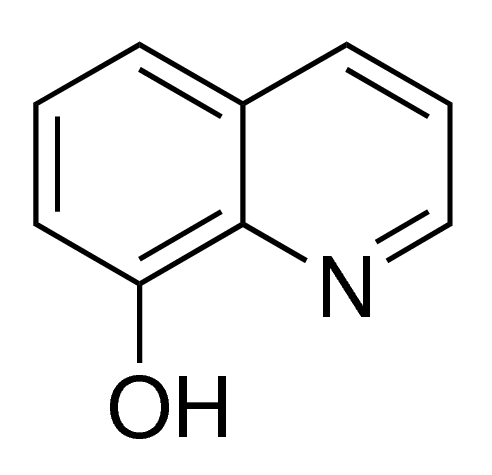8-Hydroxyquinoline CAS#: 148-24-3; ChemWhat Code: 1410805
Identification
| Product Name | 8-Hydroxyquinoline |
| IUPAC Name | quinolin-8-ol |
| Molecular Structure |  |
| CAS Registry Number | 148-24-3 |
| EINECS Number | 205-711-1 |
| MDL Number | MFCD00006807 |
| Beilstein Registry Number | 114512 |
| Synonyms | 8-quinolinol8-Hydroxyquinolinequinolin-8-ol |
| Molecular Formula | C9H7NO |
| Molecular Weight | 145.158 |
| InChI | InChI=1S/C9H7NO/c11-8-5-1-3-7-4-2-6-10-9(7)8/h1-6,11H |
| InChI Key | MCJGNVYPOGVAJF-UHFFFAOYSA-N |
| Canonical SMILES | c1cc2cccnc2c(c1)O |
| Patent Information | ||
| Patent ID | Title | Publication Date |
| CN112979718 | Ferrocenecarboxylic acid derivative as well as preparation method and application thereof | 2021 |
| US2021/300898, | SMALL MOLECULES TARGETING MUTANT MAMMALIAN PROTEINS | 2021 |
Physical Data
| Appearance | White to creamish off-white colour powder |
| Solubility | INSOLUBLE |
| Flash Point | 267°C |
| Refractive index | 1.4500 (estimate) |
| Sensitivity | Light Sensitive |
| Melting Point, °C | Solvent (Melting Point) |
| 74.8 – 75.7 | |
| 75 – 75.7 | |
| 68.5 – 71.4 | |
| 74 – 76 | chloroform |
| Boiling Point, °C | Pressure (Boiling Point), Torr |
| 160 – 172 | 690.069 |
| 122 | 0.1 |
| 266.6 | 752 |
| Density, g·cm-3 | Reference Temperature, °C | Measurement Temperature, °C |
| 1.36 | 4 | 19.84 |
| 1.1594 | 4 | 80 |
| 1.034 | 4 | 209 |
| 1.15 | 100 |
Spectra
| Description (NMR Spectroscopy) | Nucleus (NMR Spectroscopy) | Solvents (NMR Spectroscopy) | Temperature (NMR Spectroscopy), °C | Frequency (NMR Spectroscopy), MHz |
| Chemical shifts, Spectrum | 1H | chloroform-d1 | 300 | |
| Chemical shifts, Spectrum | 13C | chloroform-d1 | 101 | |
| Chemical shifts, Spectrum | 1H | dimethylsulfoxide-d6 | 39.84 | 300.2 |
| Chemical shifts, Spectrum | 1H | dimethylsulfoxide-d6 | 49.84 | 75.5 |
| Chemical shifts | 1H | chloroform-d1 | ||
| Chemical shifts | 13C | chloroform-d1 |
| Description (IR Spectroscopy) | Solvent (IR Spectroscopy) |
| Bands | potassium bromide |
| Intensity of IR bands, Bands, Spectrum | potassium bromide |
| Bands | tetrachloromethane |
| Description (UV/VIS Spectroscopy) | Solvent (UV/VIS Spectroscopy) | Absorption Maxima (UV/VIS), nm |
| Spectrum | ethanol | 246 |
| dichloromethane | 309 | |
| Spectrum | aq. buffer | 239 |
| Description (Mass Spectrometry) | Comment (Mass Spectrometry) |
| electron impact (EI), spectrum | |
| ESI (Electrospray ionisation), Tandem mass spectrometry, Spectrum | mol peak |
| spectrum, chemical ionization (CI) | |
| spectrum | collisional activation, MIKE (mass ion kinetic energy) |
Route of Synthesis (ROS)
| Conditions | Yield |
| With magnesium oxide In water at 150℃; under 0.000750075 Torr; for 2h; Temperature; Concentration; Large scale; | 95% |
| With ethanol; magnesium; nitrobenzene | |
| With magnesium hydroxide In ethanol for 6h; Heating; | |
| Multi-step reaction with 2 steps 1: sodium hydroxide / ethanol 2: water |
Safety and Hazards
| Pictogram(s) |      |
| Signal | Danger |
| GHS Hazard Statements | H301: Toxic if swallowed [Danger Acute toxicity, oral] H317: May cause an allergic skin reaction [Warning Sensitization, Skin] H318: Causes serious eye damage [Danger Serious eye damage/eye irritation] H360D: May damage the unborn child [Danger Reproductive toxicity] H400: Very toxic to aquatic life [Warning Hazardous to the aquatic environment, acute hazard] H410: Very toxic to aquatic life with long lasting effects [Warning Hazardous to the aquatic environment, long-term hazard] Information may vary between notifications depending on impurities, additives, and other factors. |
| Precautionary Statement Codes | P203, P261, P264, P264+P265, P270, P272, P273, P280, P301+P316, P302+P352, P305+P354+P338, P317, P318, P321, P330, P333+P313, P362+P364, P391, P405, and P501 (The corresponding statement to each P-code can be found at the GHS Classification page.) |
Other Data
| Transportation | Under the room temperature and away from light |
| HS Code | No data available |
| Storage | Under the room temperature and away from light |
| Shelf Life | 2 years |
| Market Price | USD |
| Druglikeness | |
| Lipinski rules component | |
| Molecular Weight | 145.161 |
| logP | 3.186 |
| HBA | 0 |
| HBD | 1 |
| Matching Lipinski Rules | 4 |
| Veber rules component | |
| Polar Surface Area (PSA) | 37.2 |
| Rotatable Bond (RotB) | 0 |
| Matching Veber Rules | 2 |
| Use Pattern |
| 8-Hydroxyquinoline CAS#: 148-24-3 inhibiting growth or proliferation of a tumor and/or immune cell |
| Agricultural use |
| bactericidal composition |
| controlling plant diseases caused by pathogens |
Buy Reagent | |
| No reagent supplier? | Send quick inquiry to ChemWhat |
| Want to be listed here as a reagent supplier? (Paid service) | Click here to contact ChemWhat |
Approved Manufacturers | |
| Watsonnoke Scientific Ltd | https://www.watsonnoke.com/ |
| Want to be listed as an approved manufacturer (Requires approvement)? | Please download and fill out this form and send back to approved-manufacturers@chemwhat.com |
Contact Us for Other Help | |
| Contact us for other information or services | Click here to contact ChemWhat |

